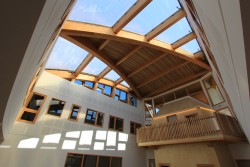The challenge when developing new state-of-the-art university buildings, is negotiating the critical pathway between speed of construction, sustainability, reducing lifecycle costs and most importantly - creating the optimum learning environment.
Designers of the new Carbon Neutral Laboratory of Sustainable Chemistry at Nottingham University and a three storey building with a lecture theatre at Essex University, determined that the solution to meet these challenges lie with solid wood.
Timber promotes well-being
Cross laminated timber is fast becoming the material of choice for designers and architects for education developments because of its numerous benefits, such as the speed and accuracy of construction, robust structural properties, along with its excellent low-carbon credentials but more recently evidence has emerged of its calming benefits. The natural and inviting environment created by cross laminated timber has seen it become a prevalent choice for educational settings.
The impact that cross laminated timber can have on its inhabitants is an area where more research is required, but evidence is emerging to suggest that timber can be used as a positive method of enhancing education environments. The effect that the internal materials can have on the comfort and well-being of its occupants, particularly in the education and the care sectors, suggests that CLT creates a comfortable internal environment that genuinely feels good, particularly when the timber is left exposed.
Along with the benefits for occupants, timber is the number one renewable mainstream construction material, producing sustainable buildings at a rapid rate and because it produces airtight and robust buildings – using CLT as the core structural solution reduces energy and maintenance requirements throughout the lifecycle of the building.
University Challenges
Development plans at the GlaxoSmithKline Carbon Neutral Laboratory of Sustainable Chemistry at Nottingham University incorporate CLT as the main structural component for the walls, floor and roofing elements that work along with the main glulam frame. The two storey, 22m tall structure includes state-of-the-art teaching and learning technology. The glulam and CLT frame captured the equivalent of nearly 1,600 tonnes of carbon through the volume of trees on the project. The pre-fabricated glulam CLT horns erected on the roof of the structure provide natural ventilation throughout the building.
Exposed timber was used in the laboratory at Nottingham University to meet sequestration targets and promote health and well-being. The building, which has reached the finals of the Structural Awards in the Best Education and Best Low Energy categories, is expected to achieve a 70% reduction in embodied carbon compared to a more traditional build.
Creating the first zero carbon business school in the UK was the main focus for the Essex University development project. Glulam beams, exposed CLT panels and wall cassettes form the main construction of the three storey building and MBA lecture theatre - delivering a ground-breaking space for students, staff and business partners to work and learn.
The business school includes a winter garden with Ethylene Tetra Fluoro Ethylene (ETFE) and timber roof, this transmits more light into the building and provides better insulation, costing less to install. The timber roof of the winter garden acts as a buffer zone by supporting the passive ventilation and heating strategy of the building.
Photovoltaics on the roof of the south facing building provide renewable energy from a combined heat and power installation, this allowed the net export of energy to offset carbon emissions from the building. It features a range of innovative sustainable elements, including the green sedum roof, solar panels and sustainably sourced material.
BREEAM ratings
Both university buildings are on target to achieve Establishment Environmental Assessment Method (BREEAM) ratings with Essex University aiming for a rating of excellence and Nottingham University set to achieve BREEAM ‘Outstanding’ and LEED ‘Platinum’ ratings.
The Nottingham University development commits to a carbon model assessment that shows the operation energy balance of the building will in 25 years pay back all of the embodied carbon of the building materials, transport emissions and site related energy emissions. When the laboratory is not in use the building becomes dormant using the minimum amount of energy and storage heating.
Using natural materials like cross laminated timber and minimising the amounts of carbon positive materials aids the building in achieving its sustainable targets.
The precision and reliability challenge
Programme certainty is vitally importance particularly with new build educational projects, as the start and finish dates often need to fit with terms times. Cross laminated timber is precision engineered in factory controlled conditions, reducing site construction time and delays from inclement weather. The development projects generally come with less programme risk and are delivered on time and on budget.
The use of cross laminated timber allowed the structures from both university developments to meet the unique challengers that were required. CLT finds the balance between a rapid and reliable solution generating an effective space for studying and learning.
As the UK partner of the X-LAM Alliance, B & K Structures of can assist at every stage of the construction journey from pre-tender design through to onsite delivery. The specialist contractor’s aim is to educate and inform construction professionals on the benefits of using cross laminated timber as a core structural component.
Learnings and Understanding
The X-LAM Alliance can assist at every stage of your construction journey – from pre-tender design through to onsite delivery and everything in between. As industry specialists, they offer one hour CPD sessions. These development sessions are tailored to meet the requirements of architects, engineers, specifiers and cover the technical and performance benefits.
To find out more information or to book a CLT CPD Session, please email: info@xlam-alliance.com or visit: www.xlam-alliance.com









